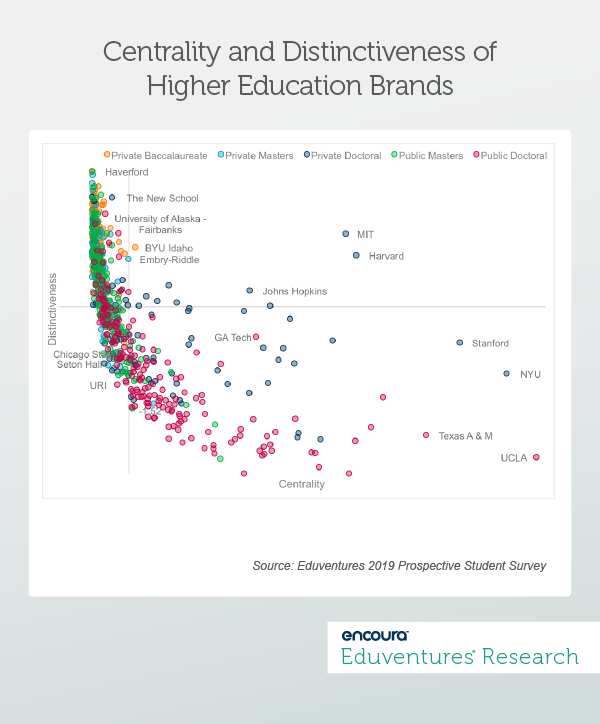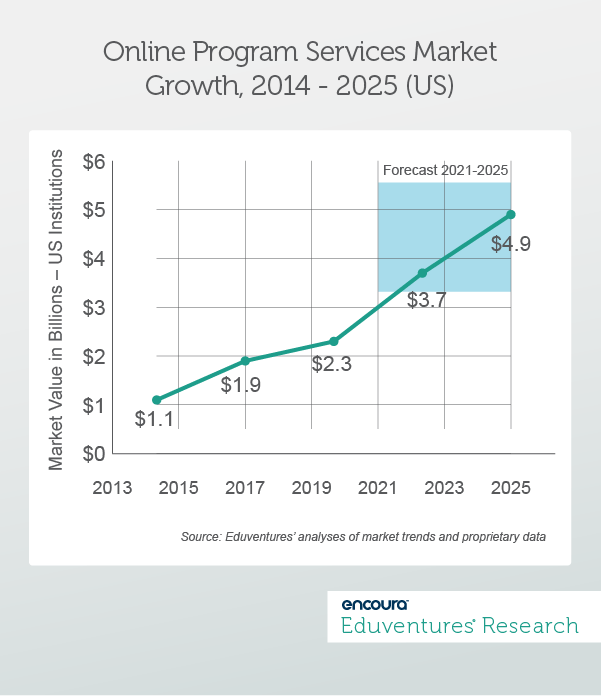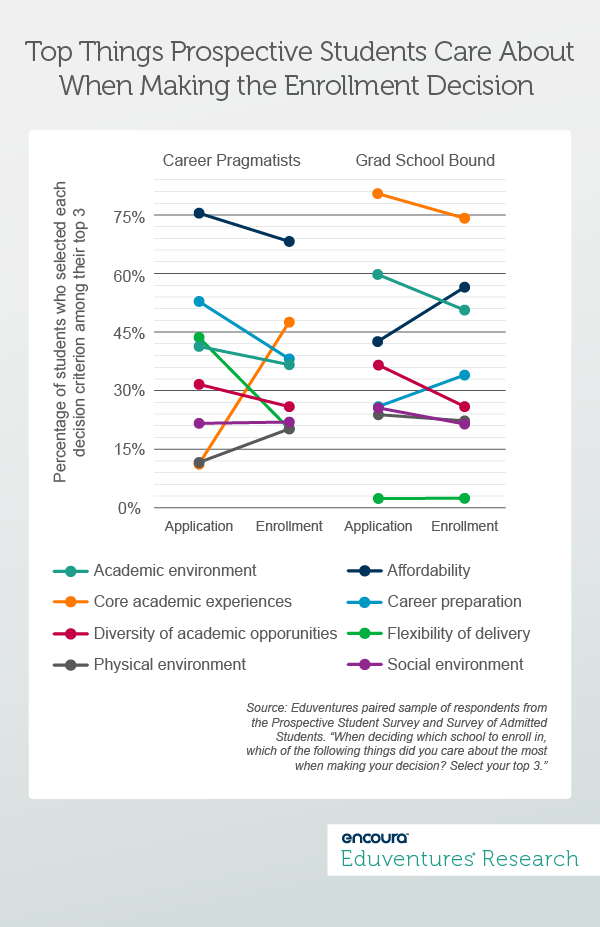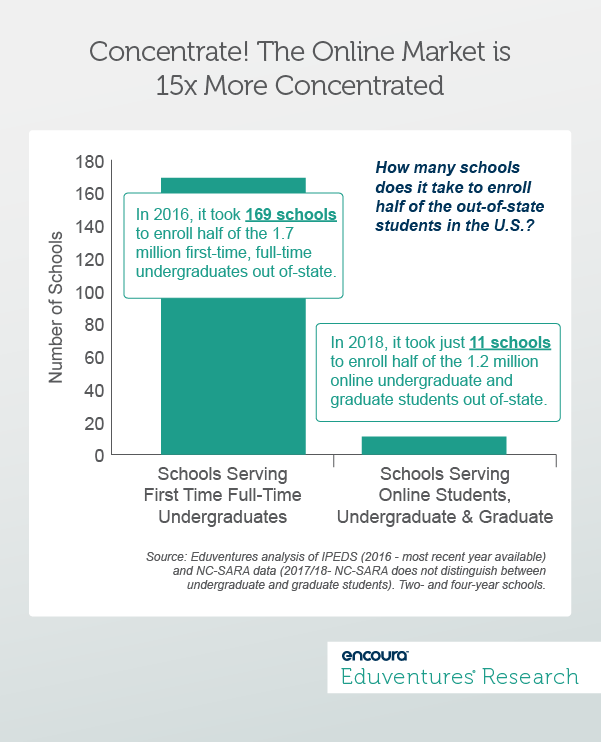What do out-of-state online enrollment, undergraduate brand distinctiveness, and the use of YouTube among high school students have in common? They are all , of course!
While main stage keynote speakers like Mitch Daniels, Mitch Landrieu, and Bill Belichick might steal the headlines, don’t overlook sessions delivered by the team of Eduventures analysts who are preparing to dazzle you with never-before-seen data and insight.
Whether you can join us this year or not, here are five highlights from some of the analyst-led sessions scheduled for Summit, June 5-7 in Boston.
- Brand Matters: the Relationship Between Students and Schools, by Kim Reid
- The Battle for Value: National vs. Local Online Markets, by Richard Garrett
- Do You Know How to “Be Real?” The Channels that Reach Gen Z, by Johanna Trovato
- Piecing Together the Online Program Management Puzzle: Buy, Build, or Both?, led by Howard Lurie
- From Application to Enrollment: How Student Preferences Change Across the Enrollment Funnel, by Cara Quackenbush
If education technology is in your wheelhouse, we’ll have sessions that focus on that too. Don’t miss next week’s Wake-Up Call for a preview of our 2019 Higher Education Technology Landscape, to be revealed this year at Summit.
Brand Matters: The Relationship between Students and Schools
By Kim Reid, Principal Analyst
The perennial problem for institutions serving traditional-aged undergraduates is that distinctive brand identity is rarely associated with mass appeal, unless you’ve been in the game for a long time. For most schools, building a distinctive brand while managing enrollment is a careful balancing act.
Prospective undergraduate students are only one facet of an overall institutional brand, but the diverse constituency of students your institution eventually serves will shape the future of that brand. That’s why we believe it’s worth thinking about prospective students as the leading edge of your brand identity.
Sourced from our Prospective Student Survey, Figure 1 maps 655 four-year-plus institutions based on the words prospective undergraduate students use to describe their brands. Each brand has been scored based on its distinctiveness (the degree to which students use language that stands out) and its centrality (the degree to which students talk about the school). This data provides a starting point for a rich discussion on brand position.

While no college or university can be all things to all people, it must be many things to many people—and most certainly the right things to the right people. Our data on institutional brand perceptions and Prospective Student Mindsets illuminates these relationships.
My Summit mainstage presentation, Brand Matters: The Relationship between Students and Schools, will discuss key features of these relationships and how they impact the facet of brand strategy that addresses the prospective student market.
The Battle for Value: National vs. Local Online Markets
Richard Garrett, Chief Research Officer
State universities, community colleges and state funding for higher education all assume one thing: higher education is local. Yes, exceptional students enroll on the other side of the country, but the norm is study in-state. Much lower in-state tuition underlines the point.
Online learning scrambles the coordinates. Schools and students can connect anywhere there is a robust Internet connection, and increasingly, online tuition is flat regardless of where a student lives. This means more choice for students, but can be frustrating for state institutions, whether state funded or just state located.
Seemingly parochial institutions like Arizona State University or Southern New Hampshire University have used online to become national giants, enrolling students in every state. Indeed, together these behemoths often enroll more state residents in online degree programs than do local universities.
This has resulted in high concentration of out-of-state online enrollment in a handful of schools (see Figure 2).
Figure 2.
A mere 11 schools, including Southern New Hampshire University (SNHU), Western Governors University, and Grand Canyon University, enroll 50% of all U.S. residents in out-of-state online higher education programs. While this means that students may get more choice, what does it mean for state institutions, state policy, and state taxpayers?
My 2019 Summit mainstage presentation—and preceding breakout workshop—will think through the implications of the rise of the online giants, and review how some states are cooperating with this trend and how others are fighting back. This topic is relevant for any school, public or private, whether one of the online giants or worried about them.
Do You Know How to “Be Real?” The Channels that Reach Gen Z
By Johanna Trovato, Senior Analyst
Gen Z is here, and much has already been said about them. Do you think you’ve learned everything you need to know about this new generation?
Our 2019 Student Sentiment Survey, which examines the college search behaviors and communication preferences of college-bound high school students, suggests that there is still more to understand. In particular, it reveals that despite their best efforts, colleges and universities often miss the mark on effective communication with these prospects. As one survey respondent put it, “some schools seemed like they were trying too hard to be cool.”
Increasingly, prospects will call you out if your recruitment outreach does not seem authentic. Worse yet, they’ll ignore you.
So, how do you convey your message to prospects in an authentic and compelling way? The students in our survey suggest that a video is worth a million words. That’s why 97% of the college-bound survey respondents are active on YouTube, and 62% use this channel in their college search – making YouTube the most commonly-used social media channel for college search (Figure 3).

And while these students like hearing from their peers—39% have watched a video from a current student—they’re also paying close attention to what institutions have to say. Seventy-six percent of college-bound high school students have watched a video from a college during their college search process.
If you would like to learn more about how to attract and keep the attention of these students, be sure to attend my workshop, The Channels that Reach Gen Z.
Piecing Together the Online Program Management Puzzle: Buy, Build, or Both?
By Howard Lurie, Principal Analyst
Schools are no strangers to the world of vendors-for-hire. Everything from food service, to grounds-keeping, to security are typically managed through a variety of service contracts. These relationships raise few eyebrows since contractors provide services that schools may not be best-suited to provide themselves.
This relative tranquility, however, is rare when it comes to outsourcing the production and management of online programs. Whether we call it online program management (OPM)–or any other novel flavor of the month–this market has experienced significant growth, as shown in Figure 4.

Alongside this growth, and its generally positive impact on enrollment, the use of outsourced vendors to produce and manage online learning has become one of the most contentious corners of the higher education landscape.
Enough. Higher education need less finger-pointing and more transparency into the design, build, launch, and management of online learning programs, whether through outsourced contracts or in-house services.
This will be my focus Friday morning, June 7, when I convene a discussion with some of the most insightful and experienced voices in this dynamic market. Representatives from Southern Methodist University, Bisk Education, University of South Alabama, and ExtensionEngine, will share their experiences responding to the market challenges and opportunities of building online programs.
We will explore a broad range of online program development issues facing both school-vendor partnerships, and in-house efforts, including: business models, evidence of student achievement, governance, and faculty buy-in. Come early, come hungry (breakfast will be served), and come ready to participate.
From Application to Enrollment: How Student Preferences Change Throughout the Enrollment Funnel
By Cara Quackenbush, Vice President of Research
Three years ago at Summit, we first unveiled our Prospective Student Mindsets (Mindsets). This attitudinal and behavioral market segmentation provided an alternative to the prevailing demographic-based view of college-bound high school students.
With every Eduventures study since then, we learn more about how these Mindsets change and grow as they move through the enrollment funnel, leaving a trail of breadcrumbs for enrollment leaders to follow. For example, Figure 5 charts the change in attitude of two sample Mindsets between the application and enrollment stages on eight key decision criteria.
The two Mindsets followed here include Career Pragmatists—highly cost-sensitive, ROI-focused students motivated predominantly by getting a good job immediately after college—and Grad School Bound students—those rare 17- and 18-year-olds whose primary objective is to use college as a stepping stone for graduate school.

At application time, Career Pragmatists care most about affordability and career preparation, while core academic experiences rank at the bottom of their list. By the time they enroll they learn to care much more about academics. Grad School Bound students, on the other hand, begin with academics on the mind but end up learning to care more about affordability.
While our surveys do not directly address the reasons students attribute to their changes in attitude, it’s a safe bet that university messaging and interactions with admissions counselors have a lot to do with it. But this type of analysis only tells part of the story. We have also learned that when it comes down to those factors that ultimately drive the enrollment decision, many of these student will underestimate the impact of certain criteria.
My workshop will follow students, beginning with the values that determine where they apply and ending with the latent factors shown to be predictive of college choice.
Join us in Boston, Massachusetts as we convene eminent thinkers, leaders, and practitioners from across the higher education spectrum to examine and showcase the best ideas, old and new. If there is one event in higher ed you attend this year, it should be Eduventures Summit.


